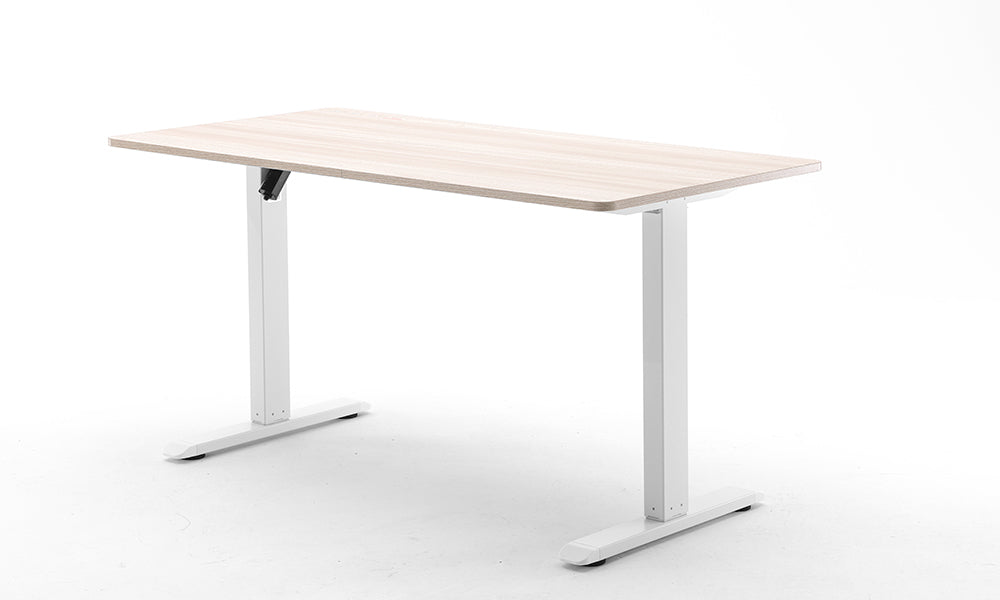The standing desk has surged in popularity as an alternative to traditional seated workstations. With growing awareness of the health risks associated with prolonged sitting, many workers and employers are investing in standing desks to foster a healthier work environment. However, choosing the right standing desk can be a daunting task, especially when faced with the decision between manual and automatic options. This guide will delve into the pros and cons of both types, helping you make an informed choice.
Understanding Standing Desks
Before diving into the specifics, it’s essential to understand what standing desks are. A standing desk, also known as a stand-up desk, allows a person to stand up comfortably while working. Many modern versions are adjustable so that the user can change the height of the desk and alternate between sitting and standing.
Manual Standing Desks
Overview
Manual standing desks require physical effort to adjust the height. They typically use a crank or a lever mechanism. Despite the manual operation, these desks have evolved to be more user-friendly and ergonomic.
Pros of Manual Standing Desks
- Cost-Effective: Manual standing desks are generally less expensive than their automatic counterparts. This affordability makes them accessible to a broader range of users, including those on a tight budget.
- Durability: With fewer electronic components, manual desks often have a longer lifespan and require less maintenance. There are no motors or electrical parts that might malfunction over time.
- Simplicity: The simplicity of manual desks means fewer things can go wrong. They do not rely on power sources, making them reliable and easy to use in various settings without the need for electrical outlets.
- Control: Some users prefer the tactile feedback of manual adjustments, finding it easier to fine-tune the height to their exact preference.
Cons of Manual Standing Desks
- Effort: Adjusting a manual desk requires physical effort, which can be inconvenient, especially if frequent adjustments are needed throughout the day.
- Time-Consuming: Changing the height manually can take longer than pressing a button, which can interrupt workflow and reduce productivity.
- Limited Features: Manual desks often lack some of the advanced features found in automatic desks, such as programmable height settings and reminders to change positions.
Automatic Standing Desks
Overview
Automatic standing desks, also known as electric or motorized desks, use electric motors to adjust the height at the push of a button. Some models come with advanced features like programmable settings and integration with health apps.
Pros of Automatic Standing Desks
- Convenience: With just a push of a button, you can adjust the desk to your preferred height. This ease of use is particularly beneficial for those who switch between sitting and standing multiple times a day.
- Speed: Automatic desks change height quickly, allowing for seamless transitions and minimal interruption to your workflow.
- Advanced Features: Many automatic desks come with programmable height settings, anti-collision technology, and even reminders to change positions. These features can enhance user experience and promote healthier working habits.
- Accessibility: For individuals with physical limitations or conditions that make manual adjustments difficult, automatic desks provide a more accessible solution.
Cons of Automatic Standing Desks
- Cost: Automatic desks are generally more expensive than manual ones, which can be a significant barrier for some users.
- Potential for Malfunctions: The presence of electrical components and motors introduces a risk of malfunctions. While many models are highly reliable, issues can arise that require repairs or replacements.
- Dependence on Power: Automatic desks need a power source, which can limit where they can be placed. In the event of a power outage, adjusting the desk may not be possible.
Key Factors to Consider When Choosing a Standing Desk
When deciding between a manual and an automatic standing desk, several factors should be taken into account:
- Budget: Determine how much you are willing to spend. Manual desks are more budget-friendly, but if your budget allows, an automatic desk might offer better long-term value due to its convenience and features.
- Frequency of Adjustment: Consider how often you will be changing the desk height. If you plan to switch positions frequently throughout the day, an automatic desk will save time and effort.
- Workspace Environment: Assess your workspace. If power outlets are limited or if you need a desk that can be easily moved, a manual desk might be more practical.
- Physical Limitations: If you have any physical limitations that make manual adjustments difficult, an automatic desk is likely the better choice.
- Desired Features: Think about which features are important to you. If you value high-tech features like programmable settings and reminders, an automatic desk will likely be more appealing.
Conclusion
Choosing between a manual and an automatic standing desk ultimately depends on your individual needs, preferences, and circumstances. Manual desks offer durability, simplicity, and cost-effectiveness, making them an excellent choice for budget-conscious buyers or those who prefer a more straightforward setup. On the other hand, automatic desks provide unmatched convenience, speed, and advanced features, making them ideal for those who prioritize ease of use and are willing to invest more for added functionality.
Incorporating a standing desk into your workspace can significantly enhance your comfort and productivity, whether you opt for a manual or an automatic model. The key is to carefully consider your specific needs and choose the desk that best aligns with your work habits and lifestyle. By doing so, you can create a healthier, more dynamic work environment that promotes well-being and efficiency.






Commenta
Questo sito è protetto da hCaptcha e applica le Norme sulla privacy e i Termini di servizio di hCaptcha.